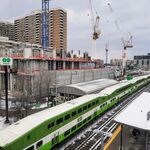Decision time' for high-speed rail, industry says
Studied for decades; North America hailed as new frontier
Mike De Souza, Canwest News Service
Published: Tuesday, January 12, 2010
http://www.nationalpost.com/story.html?id=2432017
OTTAWA - The rail industry is anticipating a busy winter in North America, propelled by billions of dollars in stimulus money for faster passenger trains from the Obama administration, and a major government-sponsored report about high-speed trains in Canada's most heavily populated region.
"It is high noon for high-speed rail," said Paul Langan, the founder of High Speed Rail Canada, a group that promotes faster and more efficient passenger rail service. "It's decision time. It's time to make a decision about the future."
In the United States, the government has announced at least $13-billion in funding that is scheduled to be awarded in the coming weeks to regions or rail corridors for upgrading their infrastructure and speeding up their trains in nearly a dozen regions, including routes that link to Vancouver, Windsor, Ont., Toronto and Montreal.
California already has a head start with a comprehensive plan co-ordinated by a state agency to build a high-speed train over the next decade that would link its major cities. Residents gave the plan an endorsement in 2008 by voting to approve almost $10-billion in public funding through the sale of bonds.
While some passenger lobby groups say better rail service can reduce the headaches of airport security and pollution from vehicles and planes, a Canadian industry association says the anticipated investments would also create opportunities for such other sectors as construction, manufacturing and steel.
"I think you can be reasonably optimistic that there's a new emerging market here that didn't exist here in North America up until now," said Cliff Mackay, president of the Railway Association of Canada, which represents rail companies and engineering firms.
"If you look at it in that context, and you look at the industrial capacity and the expertise in Canada in these sorts of systems, we're pretty well-positioned and we shouldn't miss this opportunity and I think government needs to think about that as part of their overall strategy."
High-speed rail projects have been discussed for decades in the central Canada corridor that links Quebec City, Montreal, Ottawa, Toronto and Windsor, as well as the in Calgary-Edmonton corridor in Alberta. Both the federal Liberals and Bloc Quebecois have confirmed that a high-speed rail strategy will be part of their next electoral platform, while the government of Stephen Harper has announced nearly $1-billion in rail infrastructure improvements since 2007.
Some Conservative MPs and senators have openly touted the merits of high-speed rail, but the government has not taken a stance on whether it would support a Quebec City-Windsor project that is once again being studied by the provincial and federal governments.
The final draft of the report on the corridor is due next month, after which time the federal government, Quebec and Ontario are expected to "develop a joint strategy," said briefing notes prepared for Ontario's deputy minister of transportation on May 20, 2009, obtained under Freedom of Information legislation. "It is anticipated that the study will be released to the public along with the preferred strategy."
The study updates the numbers from a report completed in 1995 that estimated a high-speed train on a dedicated track in central Canada would cost about $2-billion to complete over a 10-year period.





